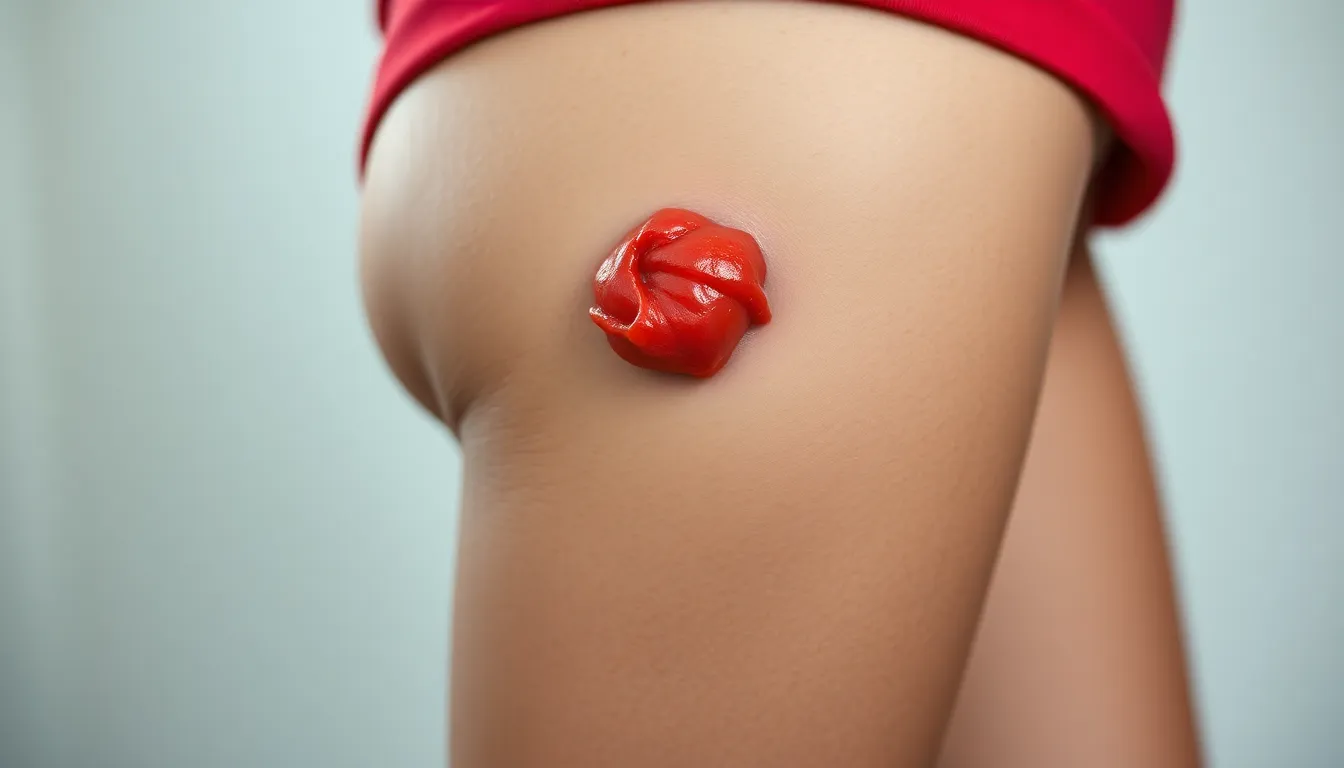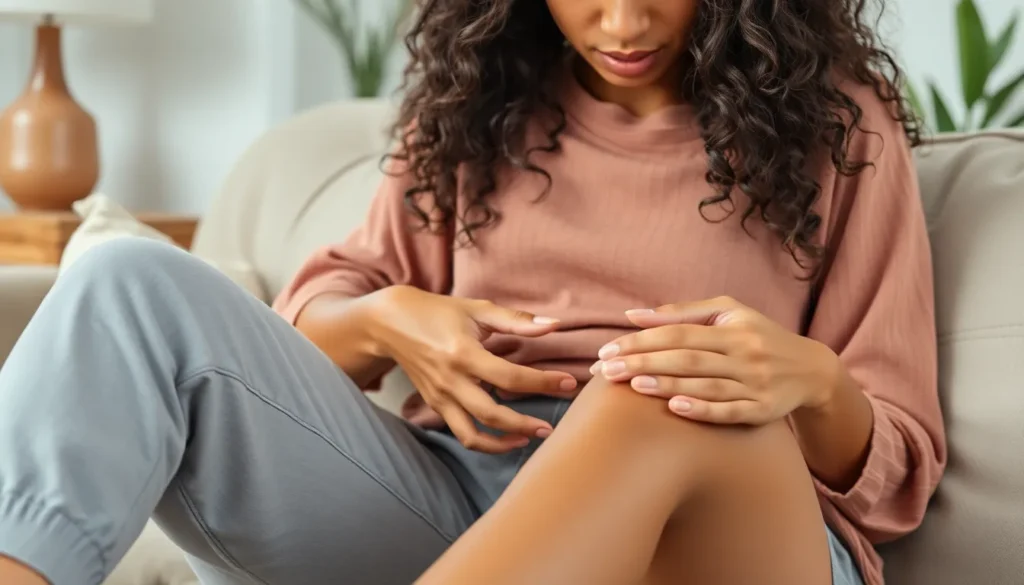Table of Contents
ToggleImagine strutting through life with confidence, only to be interrupted by an unwelcome guest on your inner thigh. Yes, we’re talking about the dreaded inner thigh boil. It’s that pesky little bump that seems to have a knack for showing up at the most inconvenient times, like when you’re trying to impress someone or simply enjoy a day out.
What Is an Inner Thigh Boil?
An inner thigh boil is a painful, pus-filled bump that forms on the skin. Occurrences typically arise due to bacterial infections, specifically from Staphylococcus aureus. Inflammation and redness often accompany these lumps. Numerous factors contribute to their development, including friction, moisture, and ingrown hairs.
Individuals frequently experience discomfort with inner thigh boils. The pressure and irritation increase with movement and friction. Boils may vary in size, with some small and a few growing larger. Sometimes, these lumps rupture and drain pus, leading to temporary relief.
Common symptoms include pain, swelling, and tenderness in the affected area. Some individuals also notice fever or chills, indicating a more severe infection. When boils recur often, underlying conditions like diabetes or immune system issues could be present.
Diagnosis involves visual examination by a healthcare professional. They may perform a culture to identify the specific bacteria involved. Treatment typically includes draining the boil and using antibiotics to address the infection. Over-the-counter pain relievers can help manage discomfort.
Preventive measures exist to reduce the risk of developing inner thigh boils. Keeping the area clean and dry is essential. Wearing loose-fitting clothing reduces friction and irritation. It’s crucial to avoid squeezing or picking at the boils, as this can worsen the infection or spread bacteria.
Causes of Inner Thigh Boils

Several factors contribute to the development of inner thigh boils. Understanding these causes can aid in prevention and management.
Bacterial Infections
Bacterial infections play a significant role in the formation of inner thigh boils. Staphylococcus aureus, a common bacterium, often causes these painful bumps. This bacteria can enter through broken skin or hair follicles, leading to inflammation and pus accumulation. When the immune system reacts to the infection, symptoms like redness, swelling, and pain arise. Maintaining personal hygiene reduces the risk of infection, while prompt treatment of any cuts or abrasions further helps prevent boils.
Ingrown Hairs
Ingrown hairs frequently contribute to inner thigh boils. When hair follicles become blocked, hair can grow sideways into the skin, causing irritation and infection. This condition often arises in areas that undergo regular friction, such as the inner thighs. People with curly hair are particularly susceptible to ingrown hairs. Managing hair removal techniques minimizes the risk. Regular exfoliation may help prevent hair from becoming trapped, reducing the likelihood of boils.
Symptoms and Diagnosis
Inner thigh boils present several symptoms that can cause discomfort and distress. Commonly reported symptoms include pain and swelling around the affected area. Individuals may also notice increased tenderness during movement or touch. Some experience fever or chills, indicating a possible systemic infection. Redness and warmth may surround the boil, signaling inflammation.
Common Symptoms
Pain manifests as a sharp sensation, particularly when walking or sitting. Swelling often occurs along with the painful lump, indicating inflammation. Tenderness increases with touch, deterring many from seeking contact. Fever may develop in some cases, reflecting the body’s immune response to infection. Chills might accompany fever, suggesting that medical attention is necessary.
Diagnostic Procedures
Healthcare professionals start diagnosis with a thorough visual examination. They assess the boil’s characteristics, including size and appearance. Depending on findings, a culture may be taken to identify specific bacteria. This cultural analysis helps determine the most effective antibiotic treatment. Regular follow-ups could be necessary to monitor healing progress or address complications.
Treatment Options
Several effective treatment options exist for inner thigh boils, ranging from home remedies to medical interventions. Choosing the right approach depends on the severity and persistence of the boil.
Home Remedies
Using warm compresses proves beneficial for many individuals. Applying a warm, moist cloth to the affected area helps soothe pain and encourages drainage. Natural antiseptics like tea tree oil or witch hazel can reduce infection risk, and applying these substances to the boil may promote healing. Keeping the boil clean enhances the effectiveness of these remedies, preventing further irritation. Additionally, resting and avoiding tight clothing will help minimize friction, aiding in the healing process.
Medical Treatments
For severe cases or recurrent boils, medical attention may be necessary. Healthcare providers often recommend drainage of the boil for immediate relief. Surgical intervention may involve making a small incision to allow pus to escape, promoting faster healing. Antibiotics may accompany this treatment if a bacterial infection is suspected or confirmed. Monitoring the area for signs of infection remains crucial. Regular follow-ups ensure that healing progresses appropriately, addressing any complications that arise.
Prevention Strategies
Maintaining specific preventive measures significantly reduces the risk of developing inner thigh boils. Focusing on hygiene and clothing choices can make a notable difference.
Hygiene Practices
Practicing good hygiene is crucial. Regularly washing the inner thigh area with mild soap helps eliminate bacteria and sweat. Keeping the skin dry is equally important; moisture creates an ideal environment for bacterial growth. Applying talcum powder or antimicrobial powder can absorb excess moisture. Trimming hair in the inner thigh region may also reduce friction and ingrown hairs. Avoiding scratching can prevent breaking the skin, lowering infection risk. Regularly changing out of sweaty clothes after exercising ensures that bacteria don’t have a chance to proliferate.
Clothing Choices
Opting for loose-fitting clothing significantly minimizes friction. Tight clothes can irritate the skin and create conditions favorable for boils. Selecting breathable fabrics allows for proper air circulation, reducing moisture buildup. Cotton or moisture-wicking materials can help keep the inner thighs dry during physical activities. During hot weather, wearing shorts instead of tight pants may also alleviate discomfort. Choosing your clothing carefully can make a notable impact on skin health.
Inner thigh boils can be more than just a physical nuisance; they can impact one’s confidence and comfort. Understanding the causes and symptoms is crucial for effective management. By prioritizing hygiene and adopting preventive measures, individuals can significantly reduce the risk of developing these painful bumps.
When boils do occur, timely treatment is essential to alleviate pain and prevent complications. Whether through home remedies or medical intervention, addressing the issue promptly can lead to quicker recovery. With the right knowledge and care, maintaining skin health in the inner thigh area is achievable, allowing for a more comfortable and confident lifestyle.

